The most northeasterly land in Hong Kong, set in Mirs Bay and far closer to mainland Shenzhen than to the Hong Kong mainland, Tung Ping Chau is the only sizeable island in Hong Kong to be built only of sedimentary rock. Its name means Flat Island, and as you approach it indeed appears almost flat, though there are some sea cliffs, chiefly along the southern coast.
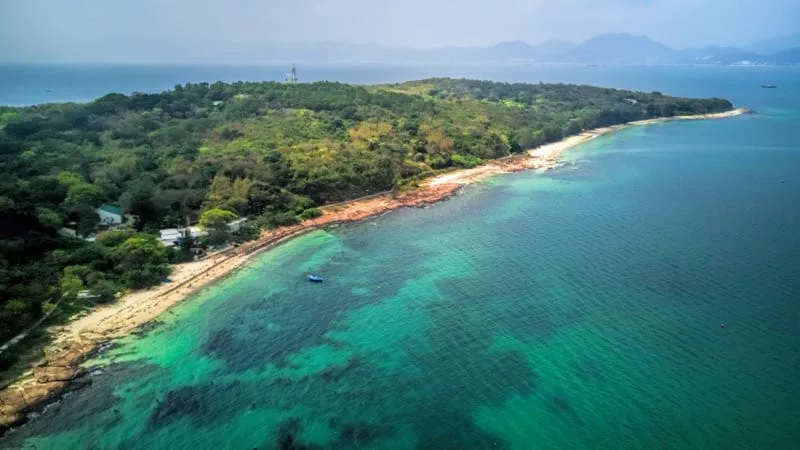
The main route to Tung Ping Chau leads out through the Tolo Channel, affording a chance to see the oldest rocks in Hong Kong – the sedimentary rocks of Bluff Head, as you travel to the island formed of Hong Kong’s youngest rocks. These sedimentary rocks are relatively uniform, and in gently dipping bands, which have given rise to the island’s profile. With no streams or major faults to produce notable valleys, Tung Ping Chau is quite unlike typical Hong Kong islands with their steep slopes and rugged headlands.
Tung Ping Chau is kidney-shaped. The inner arc faces east to the Dapeng Peninsula in Shenzhen, and is sheltered, with a gently sloping coastline, and a sandy beach north of the pier. The outer arc is more exposed to waves, which have carved low cliffs along the west and south coasts. At the southernmost tip, the cliffs rise to 48 metres, the highest point on Tung Ping Chau.
Hamlets dot the east coast and the interior. Most are deserted now, with ruined houses, but some houses in hamlets near the pier are well-maintained, chiefly as they have become small restaurants and hostels, and even small diving centres, catering to visitors arriving at weekends and during public holidays. In the hamlet of Tai Tong, north of the ferry pier, some houses have become restaurants and hostels. There has been a mini tourism boom here in recent years, especially since SARS encouraged Hongkongers to head outdoors.
Fields where islanders once grew crops including peanuts, vegetables and fruits, and grassy areas where cattle grazed, are now abandoned, and becoming densely overgrown. Small fung shui woods beside hamlets are expanding.
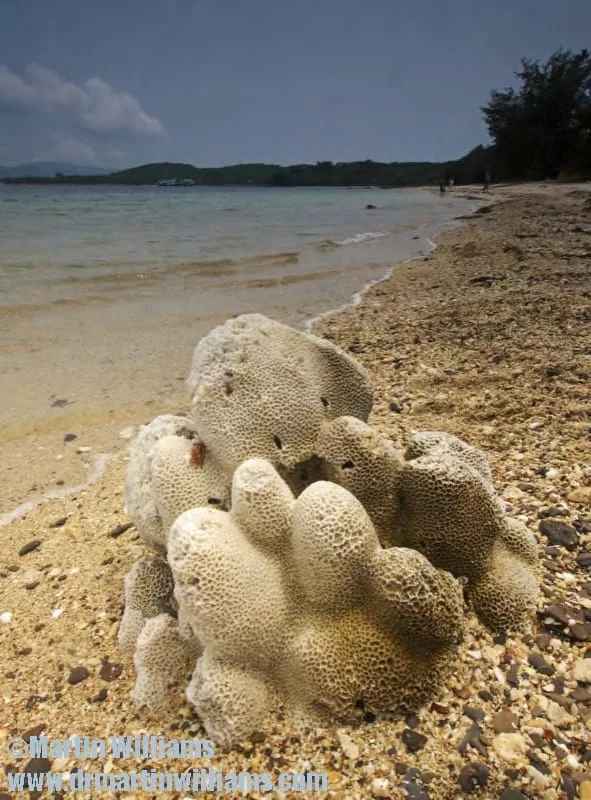
Much of the island is within Plover Cove Country Park (extension), and the surrounding waters are protected by Tung Ping Chau Marine Park. While you have to dive or snorkel to see the best marine life, some can be seen from the coast: look down from the pier as you arrive, and you may see shoals of small fish, cuttlefish, and coral heads.
Mudstone and Geological Features
Formed in an Ancient Lake
The Tung Ping Chau rocks are mainly siltstones. They formed during the Early Tertiary (Palaeocene), about 60 million years ago, in a basin that occupied much of present day Mirs Bay, and was bounded to the west by a fault running northwest from near Port Island to pass through Double Haven, and to the east by a fault running near the coast of the Dapeng Peninsula.
Probably, these siltstones formed on a succession of layers over the sedimentary rocks found on Port Island. But while the Port Island sediments originated from rivers and floods, the siltstones of Tung Ping Chau tell a story of a lake – or lakes – set in a desert like environment.

As they are fine grained, the sediments reveal that the water was still. There are layers of rock, including some slightly coarser mudstones – suggesting seasonal flooding brought sediments at certain times of year. Geologists have even found splash marks made by raindrops, so the lake sometimes almost dried out, exposing damp mud.
There are fossils here. But although Early Tertiary fossils worldwide include mammals, reptiles and the fearsome terror birds, Tung Ping Chau’s fossils are tiny. They include angiosperm (flowering plant) pollen and spores, and insects. A beetle found here was a mere 7 millimetres long.
The rock layers gently slope towards the northeast. Along the east coast there are outcrops where rock layers have been torn away, leaving smooth rock surfaces sloping into the sea. Along the west and south coasts, erosion has produced cliffs, and the more interesting geological features of Tung Ping Chau.
A New Islet Forms
At northwest Tung Ping Chau is a vantage by Chan Keng Chau, where waves have almost sliced through parallel joints in a small headland to form an islet. As yet, it is not fully separated from Tung Ping Chau: the steep channel cut by the waves is dry at low tide.
A Chert Dragon
South of Chan Keng Chau, the path runs near a bed of chert. This is especially obvious at Lung Lok Shui: “Dragon Descending to the Water”.
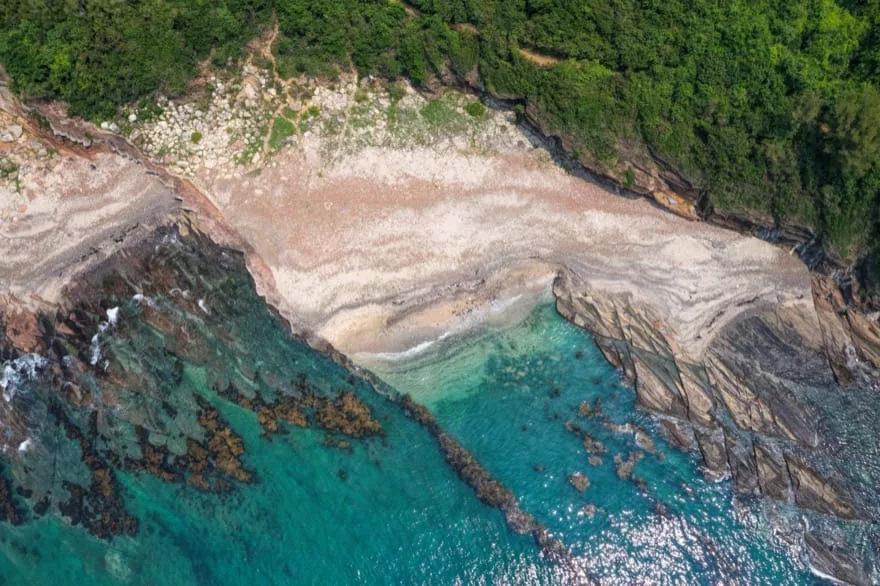
The supposed spine of the dragon is the band of whitish chert, which is some 60-80 centimetres thick. Composed of microcrystalline quartz, chert is more resistant to erosion than the mudstones and siltstones it’s sandwiched between. Coupled with its paleness, this has resulted in the so the band becoming prominent, so that in places, the rocks below have eroded so much that the chert overhangs them.
This is a far more impressive “dragon” than an identically named feature on Ma Shi Chau.
Also at Lung Lok Shui, there’s a small gravel beach. Around 200 metres to the south, a ten-metre deep sea cave – Hoi Lo Tung – has formed from erosion along a joint.
Sea Stacks and Rock Pools
At the southeast tip of Tung Ping Chau is Kang Lau Shek, where there is a wave-cut platform with two stacks – blocks of higher rock – known as the Ping Chau Watchtowers. These have formed after cliffs eroded away.
Rock pools near the stacks are home to creatures including anemones, crabs, sea urchins, prawns, and shellfish including snails (gastropods), barnacles and rock oysters. This is one of few places in Hong Kong where coral can be found in rock pools. The corals are mainly in the lowest rock pools, which are exposed during very low tides; the most common of the corals here is Porites lobata, forming crusts and nodules.
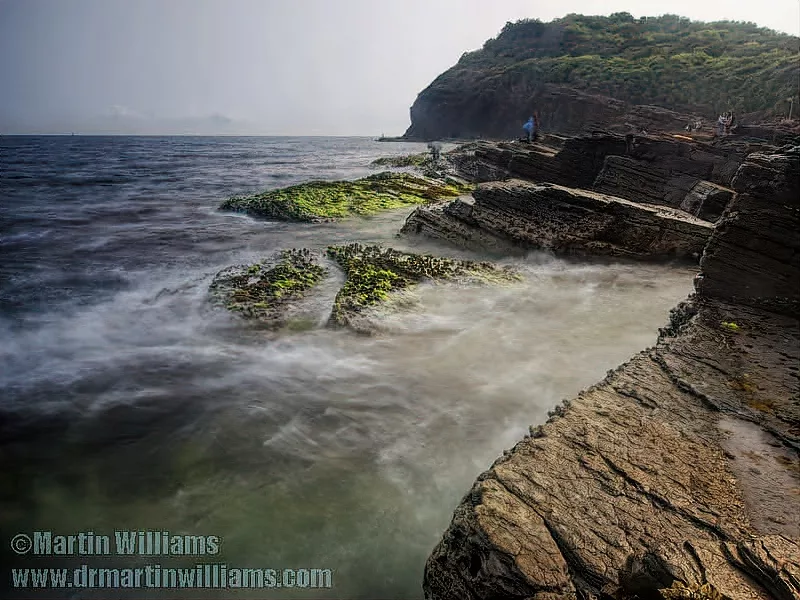
If you investigate these pools, take care, as the sloping rock surfaces are slippery when wet – and keep any disturbance to a minimum (it’s possible careless and over zealous visitors have damaged these small ecosystems). Some of the rock pools that always hold water are home to small corals, best seen during very low tides. There are also crabs, anemones, various shellfish including pearl oysters, and urchins, and you may find other creatures that have swum in during high tide, such as nudibranchs and fish. Leave the pools as you find them, including by replacing any animals you examine.
Flora and Fauna
Island of Ants
On land, Ting Ping Chau’s plants and animals are mostly unremarkable, common Hong Kong species. For instance, trees include Chinese Hackberry Celtis sinensis, Pond Spice Litsea glutinosa, Acacia Acacia confusaand figs such as Chinese Banyan Ficus microcarpa. This, plus the relatively low terrestrial biodiversity reflects the island being small, and lacking habitats such as significant wetlands – and man’s influence. Though small, the island was home to a relatively dense population, so faced intense pressures from farming.
Today, Tung Ping Chau is becoming wilder, overgrown. But the ecosystem is unbalanced – a fact reflected in recent years, when Black Tree Ants Polyrhachis dives (which are not black, and mainly nest in shrubs) have become super-abundant.
These ants can be a nuisance for visitors. They festoon some paths and even stretches of the east coast, though are perhaps patchily distributed. Wandering onto visitors’ feet and legs, the ants readily nip the skin: not painfully, but noticeably enough to be irritating.
The ants’ abundance may reflect a lack of competition, and a lack of ant predators, such as Asian Common Toads Bufo melanostictus.
The Autumn Cicada
Another Tung Ping Chau insect doesn’t nip visitors, but instead serenades them during autumn days. This is a cicada, Meimuna silhetana, and when a specimen was collected here in 2001 it was found to be a new species for Hong Kong. It is yet to be found elsewhere in the territory.
Unusually among Hong Kong’s 20 cicada species, it does not “sing” in spring or summer. Instead, its rasping buzz is heard on autumn days, from September to November.
Migratory Birds – Including Flycatchers
In common with the overall flora and fauna, Tung Ping Chau’s resident bird population is sparse. But partly thanks to its location within Mirs Bay, which is open to the South China Sea, Tung Ping Chau is attractive to migratory landbirds, such as warblers, thrushes and flycatchers. They are mainly found in the small woods along short side-trails.
Especially in early April, the flycatchers include some of Hong Kong’s most beautiful birds. Blue-and-white Flycatchers Cyanoptila cyanomelana and Narcissus Flycatchers Ficedula narcissina – are brilliantly coloured: male Narcissus Flycatchers are intense orange-yellow below, black above, with white wing patches and yellow “eyebrows”. Male Japanese Paradise-Flycatchers Terpsiphone atrocaudata are maroon above, grey below, with blue eye-rings and long tail streamers: they’re stunning birds, and are globally threatened with extinction, chiefly because of deforestation in their wintering areas in southeast Asia.
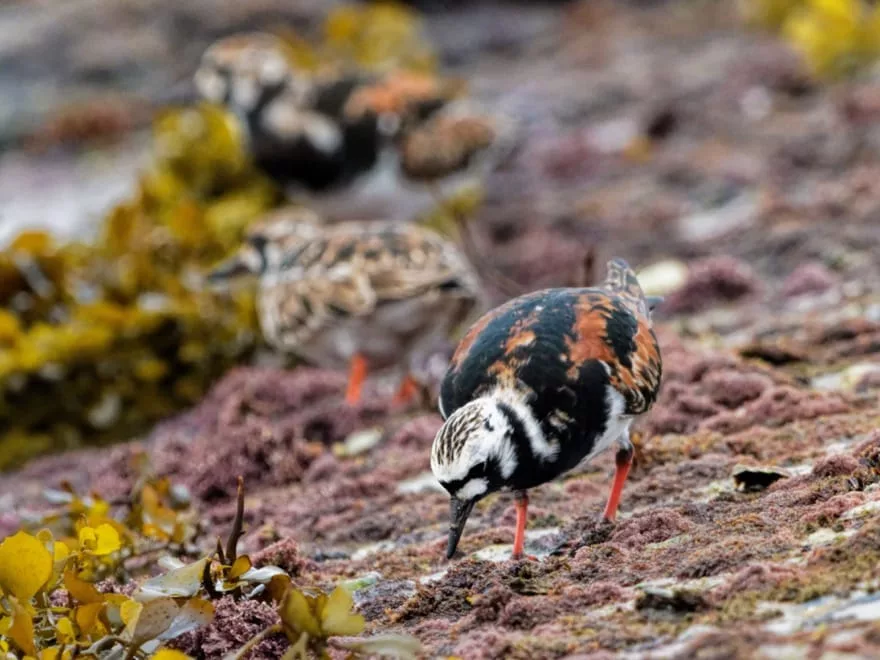
Some shorebirds also occur during migration, such as Red-necked Stint, Greater Sandplover, and Ruddy Turnstone.
Corals and Coral Fish
Some 61 of Hong Kong’s 88 known species of hard coral have been recorded around Tung Ping Chau. The dominant species include two closely related brain corals, Platygyra acuta and Platygyre carnosus, which both form castle-like structures that are striking features of the underwater landscape: these can be visible from the surface, including from the ferry pier, though it’s best to snorkel or dive to really see the coral. Other corals include the crater coral Leptastrea purpurea, which tends to be encrusting – growing across rock surfaces, or sometimes forms low, rather sprawling structures.
Though as elsewhere in Hong Kong, fish populations have been greatly reduced by over-fishing – for instance, sharks are no longer readily found in these eastern waters – over 130 species of reef-associated fishes and over 100 species of marine invertebrates such as shellfish, sponges and crabs have also been recorded around the island.
Seaweeds
The south and west coasts of Tung Ping Chau are among the best sites for seaweeds – which are better termed marine macro-algae – in Mirs Bay. Over 44 species have been recorded here to date. Growing best in cooler water, they are most prominent during winter and early spring, especially from January onwards.
Some of the seaweeds are green, such as Sea Lettuce Ulva fasciata, fronds of which may be up to a metre long. Others are brown, including one of the most plentiful seaweeds here, Sargassum, which can grow to several metres in length. The seaweeds host an array of marine creatures, including hydroids and – rarely – the bizarre Sargassum Fish Histrio histrio. This extraordinary fish is cryptically patterned and has fins and tail that are little use for swimming, but superb for disguising it as part of the waving fronds of seaweed: perfect for evading predators, and for allowing smaller fish and other animals to approach, and become Sargassum Fish food.
People sometimes harvest seaweeds for food. They indeed contain many vitamins and minerals, and may have medicinal properties. Extracts from seaweeds collected at Tung Ping Chau have been shown to reduce liver damage in laboratory rats; an extract from Hong Kong Sargassum has been found to inhibit the attachment of herpes simplex virus to its host cells.



